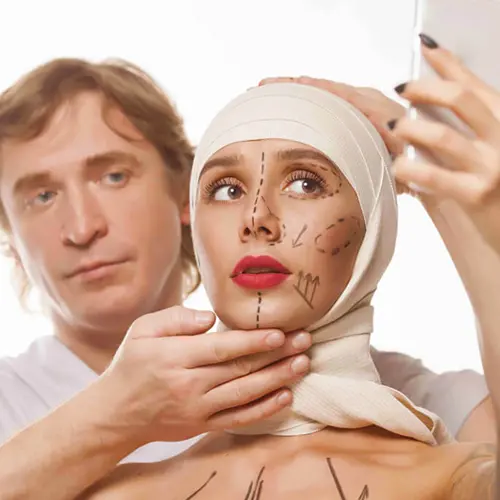Table of Contents
Laser Vision Correction is a groundbreaking advancement in ophthalmology that has revolutionized the field of vision correction. Beyond traditional methods like glasses or contact lenses, laser technology offers a more permanent solution to common vision problems.
One of the most popular forms of Laser Vision Correction is LASIK (Laser-Assisted In Situ Keratomileusis), which reshapes the cornea to correct refractive errors such as nearsightedness, farsightedness, and astigmatism.
However, advancements have been made that go beyond LASIK, offering even more precise and personalized treatments for patients.
These advancements include technologies like SMILE (Small Incision Lenticule Extraction) and PRK (Photorefractive Keratectomy), which provide alternatives to traditional LASIK procedures.
SMILE involves creating a small incision to remove a lenticule from the cornea, while PRK involves reshaping the cornea's surface directly.
Laser Vision Correction procedures are generally safe and effective, with high success rates and minimal risk of complications.
Patients who undergo these treatments often experience improved vision and reduced reliance on corrective eyewear.
Evolution of LASIK
Advancements in Laser Vision Correction: Beyond LASIK refers to the latest developments in the field of laser eye surgery that go beyond the traditional LASIK procedure to address various vision issues with improved outcomes.
The evolution of LASIK has been marked by continuous advancements in technology and techniques, leading to enhanced precision, safety, and effectiveness of laser vision correction procedures.
Initially introduced in the 1990s, LASIK has since undergone significant refinements to address a wider range of vision problems and improve patient satisfaction rates.
- Development of Wavefront Technology: One of the key advancements in laser vision correction is the integration of wavefront technology, allowing for customized treatment based on the unique characteristics of each individual's eyes.
- Introduction of Femtosecond Lasers: The advent of femtosecond lasers has revolutionized the LASIK procedure by enabling bladeless creation of corneal flaps with higher precision and safety compared to traditional microkeratomes.
- Enhanced Postoperative Care: Advances in postoperative care protocols have contributed to quicker recovery times, reduced risks of complications, and improved visual outcomes following laser vision correction procedures.
- Expanding Treatment Options: Beyond traditional LASIK, newer techniques such as PRK, SMILE, and implantable contact lenses offer alternative solutions for patients with varying needs and preferences.
New Technologies in Laser Vision Correction
Recent advancements in laser vision correction have brought about new technologies that go beyond traditional LASIK procedures.
These new technologies are revolutionizing the field of ophthalmology and offering patients more precise, effective, and customized treatment options for vision correction.
One of the breakthrough technologies in laser vision correction is wavefront-guided LASIK. This procedure uses detailed measurements of the eye's unique imperfections to create a customized treatment plan.
By analyzing the eye's entire optical pathway, wavefront-guided LASIK can address higher-order aberrations that were previously difficult to correct with traditional LASIK.
Another innovative technology is femtosecond laser-assisted cataract surgery.
This technique employs a femtosecond laser to perform precise incisions and lens fragmentation during cataract removal, improving the accuracy and safety of the procedure.
Patients undergoing this technology experience faster recovery times and better visual outcomes compared to traditional cataract surgery techniques.
Additionally, the introduction of SMILE (Small Incision Lenticule Extraction) has provided a minimally invasive alternative to LASIK for patients with myopia.
This flapless procedure preserves more corneal tissue, leading to faster healing and reduced risk of complications. SMILE has quickly gained popularity as a safe and effective option for vision correction.
SMILE Procedure
The SMILE (Small Incision Lenticule Extraction) procedure is an innovative advancement in laser vision correction that offers a minimally invasive option for patients seeking freedom from glasses and contact lenses.
Unlike traditional LASIK surgery, which involves creating a flap in the cornea, SMILE utilizes a femtosecond laser to create a small incision through which a lenticule of corneal tissue is removed to reshape the cornea.
This results in vision correction without the need for a corneal flap, leading to potentially faster recovery times and reduced risk of dry eye syndrome.
SMILE procedure offers several advantages over LASIK, such as a smaller incision size, which may promote corneal stability and biomechanical strength.
Patients undergoing SMILE often experience less discomfort during the procedure and a quicker return to normal activities.
Additionally, SMILE has been shown to be effective in treating a wide range of refractive errors, including nearsightedness and astigmatism.
Overall, the SMILE procedure represents a significant technological advancement in the field of laser vision correction, providing patients with a safe, precise, and efficient option for achieving clearer vision.
It is important for individuals considering vision correction surgery to consult with their eye care provider to determine the most suitable treatment option for their specific needs.
- Minimally invasive alternative to traditional LASIK surgery
- Utilizes femtosecond laser technology
- Does not require creation of a corneal flap
- Potentially faster recovery times and reduced risk of dry eye
- Offers smaller incision size for enhanced corneal stability
- Effective in treating various refractive errors
Potential Risks and Complications
Advancements in Laser Vision Correction technology have revolutionized the field of ophthalmology, offering patients a safe and effective way to improve their vision.
However, like any medical procedure, there are potential risks and complications associated with Laser Vision Correction that patients should be aware of.
One of the most common risks of Laser Vision Correction is overcorrection or undercorrection, which can lead to suboptimal visual outcomes.
Some patients may experience dry eyes following the procedure, which can cause discomfort and affect the quality of their vision. In rare cases, patients may develop glare, halos, or double vision, particularly in low light conditions.
Additionally, there is a small risk of infection or inflammation following the procedure, which may require further treatment.
It's important for patients to discuss these potential risks and complications with their eye care provider before undergoing Laser Vision Correction.
By understanding the possible outcomes and taking necessary precautions, patients can make an informed decision about whether the procedure is right for them.
In conclusion, while Laser Vision Correction offers numerous benefits, it's essential to be aware of the potential risks and complications involved.
With proper preoperative evaluation and postoperative care, the majority of patients can achieve excellent visual outcomes with minimal complications.
Future Trends in Laser Vision Correction
Advancements in Laser Vision Correction: Beyond LASIK have paved the way for exciting Future Trends in this field. One significant trend is the development of personalized treatment options using wavefront technology.
By creating a detailed map of the eye's unique imperfections, customized laser vision correction procedures can be tailored to each individual, resulting in improved visual outcomes and patient satisfaction.
Another key future trend is the use of femtosecond lasers in creating corneal flaps during surgery.
These ultrafast lasers offer increased precision and safety compared to traditional mechanical microkeratomes, leading to better outcomes and faster recovery times for patients.
Additionally, the integration of artificial intelligence (AI) and machine learning algorithms in pre-operative planning is expected to enhance surgical outcomes by optimizing treatment parameters based on a vast amount of patient data and clinical experience.
Furthermore, advances in corneal cross-linking techniques may extend the application of laser vision correction to patients with corneal irregularities or ectatic disorders, offering hope to individuals who were previously deemed ineligible for traditional procedures.
FAQ
What are the latest advancements in laser vision correction?
Laser vision correction has seen significant advancements beyond LASIK in recent years. One of the latest developments is the use of topography-guided treatments, which provide a more personalized and precise approach to correcting vision. Additionally, the introduction of femtosecond laser technology has improved the safety and efficacy of procedures by offering enhanced precision and faster recovery times.
How does topography-guided treatment differ from traditional LASIK?
Topography-guided treatment differs from traditional LASIK in that it takes into account the unique corneal irregularities of each individual's eye. By mapping the cornea's surface with advanced topography technology, the treatment can address not only common refractive errors but also higher-order aberrations, resulting in better visual outcomes and reduced chances of side effects like glare and halos.
What are the benefits of femtosecond laser technology in laser vision correction?
Femtosecond laser technology offers several benefits in laser vision correction procedures. This advanced technology allows for the creation of more precise and customized corneal flaps, reducing the risk of complications during surgery. The ability to create smoother flap edges and more predictable flap thickness also contributes to better visual outcomes and quicker recovery times for patients.
Are there any risks associated with the latest laser vision correction techniques?
While the latest laser vision correction techniques, such as topography-guided treatment and femtosecond laser technology, are generally considered safe and effective, there are still potential risks associated with any surgical procedure. These risks may include dry eye symptoms, glare, halos, and fluctuating vision. It's important for patients to discuss these risks with their eye care provider to make an informed decision about their treatment options.
Who is a good candidate for advanced laser vision correction procedures?
Good candidates for advanced laser vision correction procedures, such as topography-guided treatments and femtosecond laser technology, are typically individuals with stable refractive errors who are looking to improve their vision without glasses or contact lenses. It's important for candidates to have realistic expectations about the outcomes of the procedure and to undergo a comprehensive eye evaluation to determine their eligibility for treatment.
How long does it take to recover from advanced laser vision correction procedures?
The recovery time for advanced laser vision correction procedures, including topography-guided treatments and femtosecond laser technology, can vary from person to person. While some patients may experience improved vision within a few days, it's common for full visual stability to be achieved within a few weeks to a couple of months. Most patients can resume normal activities shortly after surgery, but it's essential to follow post-operative care instructions provided by the eye care provider.
Is the cost of advanced laser vision correction higher than traditional LASIK?
The cost of advanced laser vision correction procedures, such as topography-guided treatments and femtosecond laser technology, may be higher than traditional LASIK due to the advanced technology and customization involved. However, the long-term benefits and improved outcomes of these procedures may outweigh the initial costs for many patients. It's important to discuss the cost of treatment, as well as financing options, with the eye care provider during the consultation.
How can I determine if advanced laser vision correction is right for me?
If you are considering advanced laser vision correction procedures, it's important to schedule a consultation with an experienced eye care provider who can evaluate your eye health, refractive errors, and overall candidacy for treatment. During the consultation, the provider can discuss your treatment options, expected outcomes, potential risks, and answer any questions you may have to help you make an informed decision about pursuing advanced laser vision correction.




















